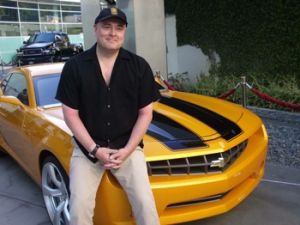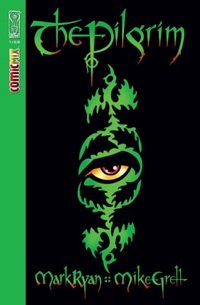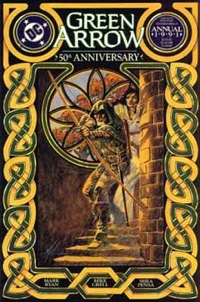Comics /
Cult Favorite
The Pilgrim Debuts April 21
By Philip Schweier
April 6, 2010 - 13:01
Having just wrapped up the latest Jon Sable adventure published by IDW, and killing off his creation, Travis Morgan, the Warlord, at DC Comics, you might think longtime creator Mike Grell would take a breather.
Collaborating with writer Mark Ryan, Grell’s next series will be
The Pilgrim, scheduled for an April 21 release date from IDW.
Grell describes
The Pilgrim as a techno-thriller – M. Night Shyamalan meets Tom Clancy. “He (Ryan) told me the story 16, 17 years ago, and I’ve been after him ever since to write it down,” said Grell. “It’s a movie waiting to be made. I’m looking forward to sitting the dark having the bejeebers scared out of me.”
The Pilgrim is based on the idea of the military applications of psychic research. According to Tibetan lore, it is possible to create a “thought form” called a Tulpa from psychic energy. Once created, that form can create other forms.
The psychics are protected from outside stimuli by a shielding device called The Bell, which in
The Pilgrim the military uses as a Zero Point Field generator to create “Sentient Exomorphic Anomalies,” or S.E.A.s.
The Pilgrim originated when Ryan began exploring the history of psychic research conducted during World War II. Col. Ken Seymour was a driving force behind efforts to use psychics to create an entity. “The more I found out what had been done,” says Ryan, “the more I sat back and developed the story about a Special Forces soldier who discovers he has this entity attached to his psyche.”
According to Ryan, Seymour was a well-respected Mason who worked with various magical and occult groups in Great Britain. “Their backs were up against it,” he says, “and Churchill was determined to wage any kind of warfare against the Nazis, including psychological and psychic warfare.”
When Allied forces broke vital German codes, they knew the Nazis would only change them if they discovered their Ultra machines had been compromised. “There’s a great quote from Winston Churchill,” says Ryan: ‘In war the truth is so precious it must always be accompanied by a bodyguard of lies.’” The allied strategy then became a campaign to convince the Nazis the Allies were reading their minds, not their radio traffic, assuring their continued use of the broken codes.
Seymour died in 1943 during one of his “psychic warfare sessions,” from a brain hemorrhage. “So secret was this op, he wasn’t buried under his own name,” says Ryan. “He was buried in someone else’s grave, under someone’s else’s name, but there are records that identify him in that grave. He’s there.”
Ryan originally envisioned the story as a film script, but as more secret history began to unfold, it became much more interesting and richer. “The comic is the best format for it as much of the material is declassified and the background is coming to light,” he says.
 |
| Mark Ryan with the Bumblebee Camaro |
“It’s a very dark, rich and twisted environment for me. It’s a complex story based on historical elements that we’re still feeling the impact today. One of the elements is how the various intelligence agencies had spent time with psychics trying to locate Osama Bin Laden,” Ryan said.
If the name Mark Ryan sounds familiar, fans may recognize him as the voice of Bumblebee in the first Transformers movie, and as the voice of Jetfire in the sequel.
He has appeared in dozens of films and television series, both in the United States and Great Britain, and originated the character "Nasir" for the British TV series Robin of Sherwood.
“The character I played, Nasir, has become grafted onto the legend of Robin Hood, which I’m quietly very proud of,” says Ryan. “Since then there has always been a Moorish or Arabic character in all the newer Robin Hood films.”
Ryan met Grell when the two of them were both appearing at a convention back in the 1980s. “I was doing a fan convention in Seattle, having a ball, and during one of the panels I was on, one arm kept popping up, asking questions,” says Ryan. “Later, we found ourselves in a bar at the hotel and was approached by that arm, a hale fellow well met, and full of the joys of spring, and it was Mike Grell and we got on like a house on fire. We ended up escaping. Mike took us to see the sites of Seattle, and the convention organizers weren’t very happy about that.”
Ryan started writing books like
The Greenwood Tarot and wrote a screenplay entitled
Pendragon, which he showed to Grell. “He enjoyed it visually, and drawing the pictures seemed a natural step, and he asked me, ‘Would you be interested in writing a comic book?’” They collaborated on
Green Arrow Annual #4, the 50th anniversary issue.
Ryan does regard himself as a very visual storyteller. “It’s quite a useful ability to have,” he says with a laugh. “It’s like having a movie playing in my head and I’m the only one who bought tickets!”
Last Updated: March 3, 2025 - 20:40


